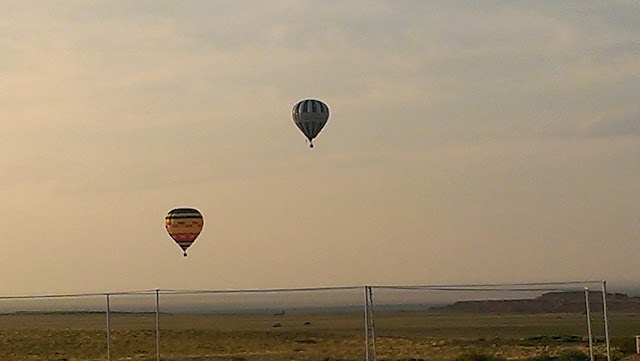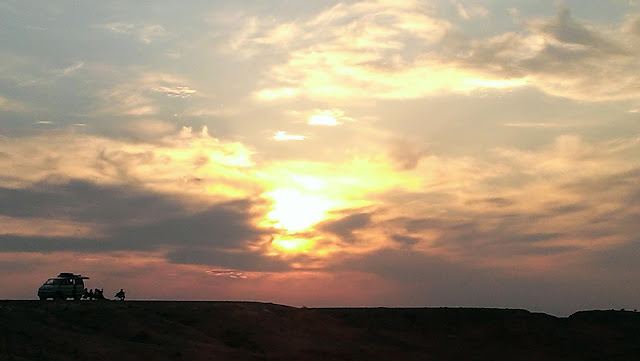I packed after dinner and got to bed about 10:00. I set my alarm for 4:10, as the hotel promised breakfast at 4:15 to accommodate our 4:45 departure for the airport. Our driver showed up on time, but it took a few minutes to say goodbye and take a last group photo, but finally we made it to the airport for our 6:45 departure.
Our flight was on an Aero Mongolia Fokker 50 - I was pleasantly surprised that I had adequate legroom and they provided a nice breakfast snack.
We flew to Dalanzadgad, almost due south of Ulaanbaatar some 540 km (325 miles). It is about 15,000 people, is on the eastern edge of the Gobi and is a major gateway for tourists. Gobi means desert in Mongolian, so while we Americans might say the Gobi Desert, it really is just referred to as the Gobi - the desert.
We were greeted by our tour guide Bayarmar. During the school year, she teaches Russian to high school students. In the summer, she is a tour guide. She let us know that the vans that we were supposed to have did not reach Dalanzadgad, so she had hurriedly procured the services of a different driver and his van - a rugged model made in Russia. It is a most reliable and rugged vehicle, capable of going most anywhere (as we later learned). Luxury, comfort and space were not included.
We drove for a couple of hours, covering some 70-80 kms of very open land - no paved roads, no signs, just open roads and the driver picked whatever ruts in the grass headed us in the general direction of Bayanzag and the flaming cliffs.
I had anticipated that our conditions would be rather spartan and our meals would be limited. I had a 50 pack of wet wipes for cleaning up, and enough clothes to change each day. But was I wrong. Our first stop was the Gobi Tour ger camp. Ger rhymes with hair; yurt is the word we Americans hear, but that is simply Russian for ger.
Since we had an hour before lunch, I wandered around. Many people assume that deserts have little or no flora or fauna. That was my assumption before starting to volunteer at the Desert Botanical Garden in Phoenix - but my wanderings before lunch show just how much flora there is.
There were many lizards, with bodies about three inches long and a tail that it coils up and straightens out. They are well camoflaged - this one is just a little below and to the left of the center of the photo.
Before lunch, we got to watch a 20 minute DVD explaining how an expedition from the American Museum of Natural History in New York had found dinosaur bones and eggs at the Flaming Cliffs (that is why there is a dinosaur statue at the entrance of the ger camp).
Besides gers to sleep in, there was a bath house building that had toilets, sinks, showers - and a sauna. The restaurant building was a large ger with plenty of room for many groups or individuals.
After salad, the main plate had rice, sauteed peppers and onions, a radish curl, beef, potatoes, and beets. There was also packages of pastries for dessert.
After lunch, we went to the flaming cliffs - all were a rich red color.
After mining and construction, tourism is Mongolia's next largest industry. So of course, even though we are in the middle of nowhere in the middle of the Gobi, there was a stand selling ice cream and cold drinks, as well as several stands selling momentoes to the tourists.
I got separated from the rest of the group - they followed Bayarmar on a hike through the cliffs. But I found more flora and interesting formations of rock.
There was an area where people with self contained camping setups were parked.
After a couple of hours at the cliffs, we drove to a nearby saxaul (not sexual, saxaul) forest. Saxaul (or saksaul) trees exist only in central Asia and in the Gobi, often become the predominant flora in a given area. Being highly drought resistant, it is planted to stabilize dunes and sand. We had seen a couple of saxaul farms on our drive in the morning, but only now when I can research them have I found why they are important to the Gobi.
On the way back to our ger camp, we stopped at this interesting rock formation.
After an excellent three course dinner with a couple of cold beers, we went outside only to see several hot air balloons launching in the evening sun.
There was some miscommunication between our guide Bayarmar and our driver Munkh (neither the first nor the last time on our trip), but we did get out to the west of the flaming cliffs to see how red they became as the sun set.
Here are a couple of nice shots of the sun setting over the Gobi.
Then it was back to the ger camp. A very nice first day introduction to the Gobi.
 |
| Lara with an over sized Morin Khuur, a two stringed Mongolian musical instrument |
We flew to Dalanzadgad, almost due south of Ulaanbaatar some 540 km (325 miles). It is about 15,000 people, is on the eastern edge of the Gobi and is a major gateway for tourists. Gobi means desert in Mongolian, so while we Americans might say the Gobi Desert, it really is just referred to as the Gobi - the desert.
We were greeted by our tour guide Bayarmar. During the school year, she teaches Russian to high school students. In the summer, she is a tour guide. She let us know that the vans that we were supposed to have did not reach Dalanzadgad, so she had hurriedly procured the services of a different driver and his van - a rugged model made in Russia. It is a most reliable and rugged vehicle, capable of going most anywhere (as we later learned). Luxury, comfort and space were not included.
 |
| I was riding shotgun, Bayarmar, Jeannie, Lara and Erika in the middle row |
 |
| Jonathan, Franz, Thai and Minh in the back row |
 |
| We had many good laughs as we set out |
I had anticipated that our conditions would be rather spartan and our meals would be limited. I had a 50 pack of wet wipes for cleaning up, and enough clothes to change each day. But was I wrong. Our first stop was the Gobi Tour ger camp. Ger rhymes with hair; yurt is the word we Americans hear, but that is simply Russian for ger.
 |
| Inside the ger that Franz, Jonathan and I shared |
Since we had an hour before lunch, I wandered around. Many people assume that deserts have little or no flora or fauna. That was my assumption before starting to volunteer at the Desert Botanical Garden in Phoenix - but my wanderings before lunch show just how much flora there is.
There were many lizards, with bodies about three inches long and a tail that it coils up and straightens out. They are well camoflaged - this one is just a little below and to the left of the center of the photo.
Before lunch, we got to watch a 20 minute DVD explaining how an expedition from the American Museum of Natural History in New York had found dinosaur bones and eggs at the Flaming Cliffs (that is why there is a dinosaur statue at the entrance of the ger camp).
Besides gers to sleep in, there was a bath house building that had toilets, sinks, showers - and a sauna. The restaurant building was a large ger with plenty of room for many groups or individuals.
 |
| Jeanie, Franz, Erika, Jonathan, Bayarmar, Minh, Thai, Lara |
After lunch, we went to the flaming cliffs - all were a rich red color.
After mining and construction, tourism is Mongolia's next largest industry. So of course, even though we are in the middle of nowhere in the middle of the Gobi, there was a stand selling ice cream and cold drinks, as well as several stands selling momentoes to the tourists.
I got separated from the rest of the group - they followed Bayarmar on a hike through the cliffs. But I found more flora and interesting formations of rock.
There was an area where people with self contained camping setups were parked.
After a couple of hours at the cliffs, we drove to a nearby saxaul (not sexual, saxaul) forest. Saxaul (or saksaul) trees exist only in central Asia and in the Gobi, often become the predominant flora in a given area. Being highly drought resistant, it is planted to stabilize dunes and sand. We had seen a couple of saxaul farms on our drive in the morning, but only now when I can research them have I found why they are important to the Gobi.
After an excellent three course dinner with a couple of cold beers, we went outside only to see several hot air balloons launching in the evening sun.
There was some miscommunication between our guide Bayarmar and our driver Munkh (neither the first nor the last time on our trip), but we did get out to the west of the flaming cliffs to see how red they became as the sun set.
Here are a couple of nice shots of the sun setting over the Gobi.
Then it was back to the ger camp. A very nice first day introduction to the Gobi.













































is that a rock suspended by rope in the ger?
ReplyDeleteYes, to help hold the ger down when the wind blows.
Deleteahhh... Thanks! (I was wondering about that.)
DeleteSeveral of your landscape and sunset pics are postcard worthy!
ReplyDeleteThe joy of digital cameras. I can take hundreds of photos and videos, and post the better ones online. As for postcards - maybe.
Delete